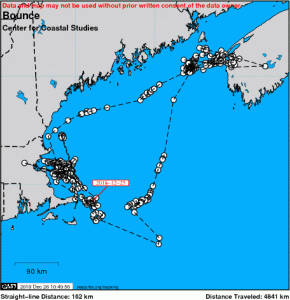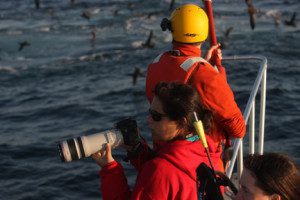Satellite Tagging
Satellite-monitored radio tags have yielded important information for the conservation and management of large whales. Tags provide far greater detail on large whale movements and habitat use than more traditional studies, and past tagging projects have revealed the existence of entirely unknown whale habitats. As such, tagging represents an important tool for the conservation of whales. However, it is not uncommon for tags to stop transmitting within days to months of deployment, and follow-up studies to assess impacts on the whales have been limited. Further work is needed to improve the scientific and conservation value of this technology.

Bounce spent Christmas Day in 2018 foraging east of Chatham, Massachusetts. Data visualization provided by seaturtle.org.
We are working to better understand and improve satellite tagging as part of long-term research on Gulf of Maine humpback whales. CCS has studied this population since the 1970s, and its strong fidelity to feeding sites, long feeding ground residency and accessibility are expected to allow repeated observations of tagged whales within the tagging year and many years into the future. Learn more about our population studies here.
The primary goals of satellite tagging research are to better understand humpback whale movement and habitat use, to better understand possible impacts on tagged individuals and provide data to improve tag performance while minimizing effects.
This study was performed in the southwest Gulf of Maine, and especially in and adjacent to the Stellwagen Bank National Marine Sanctuary. Tagging was conducted by NOAA Marine Mammal Laboratory tagging experts under scientific research permits #14245 and #20465. CCS monitors tagged whales throughout the feeding season to evaluate whale and tag status. Many whale watching naturalists in the region also share their opportunistic sightings and images with CCS in support of this study.
Two types of tags were used in this study. The first was an implantable satellite tag that is commonly used on humpbacks and other large whales. Our co-investigators in this research have included scientists and veterinarians from the Australian Antarctic Division, Cascadia Research Collective, the NOAA Marine Mammal Laboratory and The Marine Mammal Center. Funders of this work have included the National Oceanographic Partnership Program (NOPP), NOAA, Exxon-Mobile, the National Fish and Wildlife Foundation, the Marine Mammal Commission and the Office of Naval Research.
The second tag evaluated in this research was a smaller type that is more commonly deployed on the dorsal fin of toothed whales (known as a LIMPET tag) . Our co-investigators for that work included the Alaska Sealife Center, Cascadia Research Collective and University of Alaska Fairbanks. LIMPET tag research was funded by the Pacific Life Foundation Marine Mammal Research Fund at the Ocean Foundation.



